Use of Miniature Step Gauges to Assess the Performance of 3D Optical Scanners and to Evaluate the Accuracy of a Novel Additive Manufacture Process
Abstract
1. Introduction
2. Materials and Methods
2.1. Step Gauge Artifact
2.2. Measuring Equipment and Scanning Parameters
2.2.1. Structured Light Scanner (SLS)
2.2.2. Photogrammetry Based Scanner (PSSRT)
2.2.3. Laser Based Scanner (LLS)
2.3. Measurement Procedure
2.4. Uncertainty Assessment
3. Results and Discussion
4. Application to Additive Manufactured TCP Step Gauges
5. Conclusions
Author Contributions
Funding
Acknowledgments
Conflicts of Interest
References
- Imkamp, D.; Berthold, J.; Heizmann, M.; Kniel, K.; Peterek, M.; Schmitt, R.; Seidler, J.; Sommer, K.-D. Challenges and trends in manufacturing measurement technology—The “Industrie 4.0” concept. J. Sens. Sens. Syst. 2016, 83, 325–335. [Google Scholar] [CrossRef]
- Barbero, B.R.; Ureta, E.S. Comparative study of different digitization techniques and their accuracy. CAD Comput. Aided Des. 2011, 43, 188–206. [Google Scholar] [CrossRef]
- Mian, S.H.; Al-Ahmari, A. Comparative analysis of different digitization systems and selection of best alternative. J. Intell. Manuf. 2019, 30, 2039–2067. [Google Scholar] [CrossRef]
- Zhou, S.; Xu, J.; Tao, L.; Yan, Y. Performance evaluation of laser line scanner for in-process inspection of 3D geometries. In Proceedings of the Eighth International Symposium on Advanced Optical Manufacturing and Testing Technology (AOMATT2016), Suzhou, China, 26–29 April 2016; p. 96843K. [Google Scholar]
- Bia, Z.M.; Wang, L. Advances in 3D data acquisition and processing for industrial applications. Robot. Comput. Integr. Manuf. 2010, 26, 403–413. [Google Scholar] [CrossRef]
- Gerbino, S.; Del Giudice, D.M.; Staiano, G.; Lanzotti, A.; Martorelli, M. On the influence of scanning factors on the laser scanner-based 3D inspection process. Int. J. Adv. Manuf. Technol. 2016, 84, 1787–1799. [Google Scholar] [CrossRef]
- Campanelli, V.; Howell, S.M.; Hull, M.L. Accuracy evaluation of a lower-cost and four higher-cost laser scanners. J. Biomech. 2016, 49, 127–131. [Google Scholar] [CrossRef]
- Renne, W.; Ludlow, M.; Fryml, J.; Schurch, Z.; Mennito, A.; Kessler, R.; Lauer, A. Evaluation of the accuracy of 7 digital scanners: An in vitro analysis based on 3-dimensional comparisons. J. Prosthet. Dent. 2017, 118, 36–42. [Google Scholar] [CrossRef] [PubMed]
- Barnfather, J.D.; Goodfellow, M.J.; Abram, T. Photogrammetric measurement process capability for metrology assisted robotic machining. Meas. J. Int. Meas. Confed. 2016, 78, 29–41. [Google Scholar] [CrossRef]
- Galantucci, L.M.; Guerra, M.G.; Lavecchia, F. Photogrammetry Applied to Small and Micro Scaled Objects: A Review. Lect. Notes Mech. Eng. 2018, 57–77. [Google Scholar] [CrossRef]
- Trzepiecinski, T.; Malinowski, T.; Pieja, T. Experimental and numerical analysis of industrial warm forming of stainless steel sheet. J. Manuf. Process. 2017, 30, 532–540. [Google Scholar] [CrossRef]
- Wieczorowski, M.; Rucinski, M.; Koteras, R. Application of optical scanning for measurements of castings and cores. Arch. Foundry Eng. 2010, 10, 265–268. [Google Scholar]
- Lin, A.C.; Hui-Chin, C. Automatic 3D measuring system for optical scanning of axial fan blades. Int. J. Adv. Manuf. Technol. 2011, 57, 701–717. [Google Scholar] [CrossRef]
- Brajlih, T.; Tasic, T.; Drstvensek, I.; Valentan, B.; Hadzistevic, M.; Pogacar, V.; Balic, J.; Acko, B. Possibilities of Using Three-Dimensional Optical Scanning in Complex Geometrical Inspection. Stroj. Vestn. J. Mech. Eng. 2011, 57, 826–833. [Google Scholar] [CrossRef]
- Trifkovic, B.; Budak, I.; Todorovic, A.; Vukelic, D.; Lazic, V.; Puskar, T. Comparative analysis on measuring performances of dental intraoral and extraoral optical 3D digitization systems. Meas. J. Int. Meas. Confed. 2014, 47, 45–53. [Google Scholar] [CrossRef]
- Peterka, J.; Morovič, L.; Pokorný, P.; Kováč, M.; Hornák, F. Optical 3D scanning of Cutting tools. Appl. Mech. Mater. 2013, 421, 663–667. [Google Scholar] [CrossRef]
- Salvi, J.; Fernandez, S.; Pribanic, T.; Llado, X. A state of the art in structured light patterns for surface profilometry. Pattern Recognit. 2010, 43, 2666–2680. [Google Scholar] [CrossRef]
- VDI. VDI-Standard: VDI/VDE 2634 Blatt 2 Optical 3D Measuring Systems—Optical Systems Based on Area Scanning 2012; VDI: Düsseldorf, Germany, 2012. [Google Scholar]
- VDI. VDI-Standard: VDI/VDE 2634 Blatt 3 Optical 3D Measuring Systems—Multiple View Systems Based on Area Scanning 2008; VDI: Düsseldorf, Germany, 2008. [Google Scholar]
- Beraldin, J.-A.; Carrier, B.; Mackinnon, D.; Cournoyer, L. Characterization of Triangulation—Based 3D Imaging Systems Using Certified Artifacts. NCSL Int. Meas. J. Meas. Sci. 2012, 7, 50–60. [Google Scholar] [CrossRef]
- Zhao, W.L.; Zhao, C.; Cheng, J.T.; Yue, H.Y. Accuracy Verification Method about Optical Three-Dimensional Measuring Instrument. Adv. Mater. Res. 2010, 142, 204–208. [Google Scholar] [CrossRef]
- Eiríksson, E.R.; Wilm, J.; Pedersen, D.B.; Aanæs, H. Precision and Accuracy Parameters in Structured Light 3-D Scanning. Int. Arch. Photogramm. Remote Sens. Spat. Inf. Sci. 2016, XL-5/W8, 7–15. [Google Scholar]
- Martínez-Pellitero, S.; Cuesta, E.; Giganto, S.; Barreiro, J. New procedure for qualification of structured light 3D scanners using an optical feature-based gauge. Opt. Lasers Eng. 2018, 110, 193–206. [Google Scholar] [CrossRef]
- Dury, M.R.; Brown, S.; McCarthy, M.; Woodward, S. 3D Optical Scanner Dimensional Verification Facility at the NPL’s “National FreeForm Centre”. In Proceedings of the Laser Metrology and Machine Performance XI (LAMDAMAP 2015), Huddersfield, UK, 17–18 March 2015; pp. 187–197. [Google Scholar]
- Iuliano, L.; Minetola, P.; Salmi, A. Proposal of an innovative benchmark for comparison of the performance of contactless digitizers. Meas. Sci. Technol. 2010, 21, 105102. [Google Scholar] [CrossRef]
- Acko, B.; McCarthy, M.; Haertig, F.; Buchmeister, B. Standards for testing freeform measurement capability of optical and tactile coordinate measuring machines. Meas. Sci. Technol. 2012, 23, 94013. [Google Scholar] [CrossRef]
- Genta, G.; Minetola, P.; Barbato, G. Calibration procedure for a laser triangulation scanner with uncertainty evaluation. Opt. Lasers Eng. 2016, 86, 11–19. [Google Scholar] [CrossRef]
- Dury, M.R.; Woodward, S.D.; Brown, S.B.; McCarthy, M.B. Surface finish and 3D optical scanner measurement performance for precision engineering. In Proceedings of the 30th Annual Meeting of the American Society for Precision Engineering, Austin, TX, USA, 1–6 November 2015; pp. 419–423. [Google Scholar]
- De Chiffre, L.; Carmignato, S.; Cantatore, A.; Jensen, J.D. Replica calibration artefacts for optical 3D scanning of micro parts. In Proceedings of the 9th International Conference of the European Society for Precision Engineering and Nanotechnology, EUSPEN, San Sebastian, Spain, 2–5 June 2009; pp. 352–355. [Google Scholar]
- Cantatore, A.; Angel, J.; De Chiffre, L. Material investigation for manufacturing of reference step gauges for CT scanning verification. In Proceedings of the 12th International Conference of the European Society for Precision Engineering and Nanotechnology, EUSPEN, Stockholm, Sweden, 4–8 June 2012; pp. 129–132. [Google Scholar]
- Angel, J.; De Chiffre, L.; Kruth, J.P.; Tan, Y.; Dewulf, W. Performance evaluation of CT measurements made on step gauges using statistical methodologies. CIRP J. Manuf. Sci. Technol. 2015, 11, 68–72. [Google Scholar] [CrossRef][Green Version]
- Felzmann, R.; Gruber, S.; Mitteramskogler, G.; Tesavibul, P.; Boccaccini, A.R.; Liska, R.; Stampfl, J. Lithography-based additive manufacturing of cellular ceramic structures. Adv. Eng. Mater. 2012, 14, 1052–1058. [Google Scholar] [CrossRef]
- Lithoz LCM-Technology. Available online: http://www.lithoz.com/en/additive-manufacturing/lcm-technology (accessed on 15 February 2019).
- Lavecchia, F.; Guerra, M.G.; Galantucci, L.M. Performance verification of a photogrammetric scanning system for micro-parts using a three-dimensional artifact: Adjustment and calibration. Int. J. Adv. Manuf. Technol. 2018, 96, 4267–4279. [Google Scholar] [CrossRef]
- Cignoni, P.; Montani, C.; Scopigno, R. A comparison of mesh simplification algorithms. Comput. Graph. 1998, 22, 37–54. [Google Scholar] [CrossRef]
- Cloud Compare 3D Point Cloud and Mesh Processing Software—Open Source Project. Available online: https://www.cloudcompare.org/ (accessed on 12 October 2018).
- Zeiss Calypso. The Easy Way to Get from the Drawing to the Measurement. Available online: https://www.zeiss.com/metrology/products/software/calypso-overview/calypso.html (accessed on 12 February 2019).
- GOM INSPECT Evaluation Software for 3D Measurement Data. Available online: https://www.gom.com/3d-software/gom-inspect.html (accessed on 15 November 2018).
- ISO. ISO 14253-2:2011 Geometrical Product Specifications (GPS)—Inspection by Measurement of Workpieces and Measuring Equipment—Part 2: Guidance for the Estimation of Uncertainty in GPS Measurement, in Calibration of Measuring Equipment and in Product Verification 2011; ISO: Geneva, Switzerland, 2011. [Google Scholar]

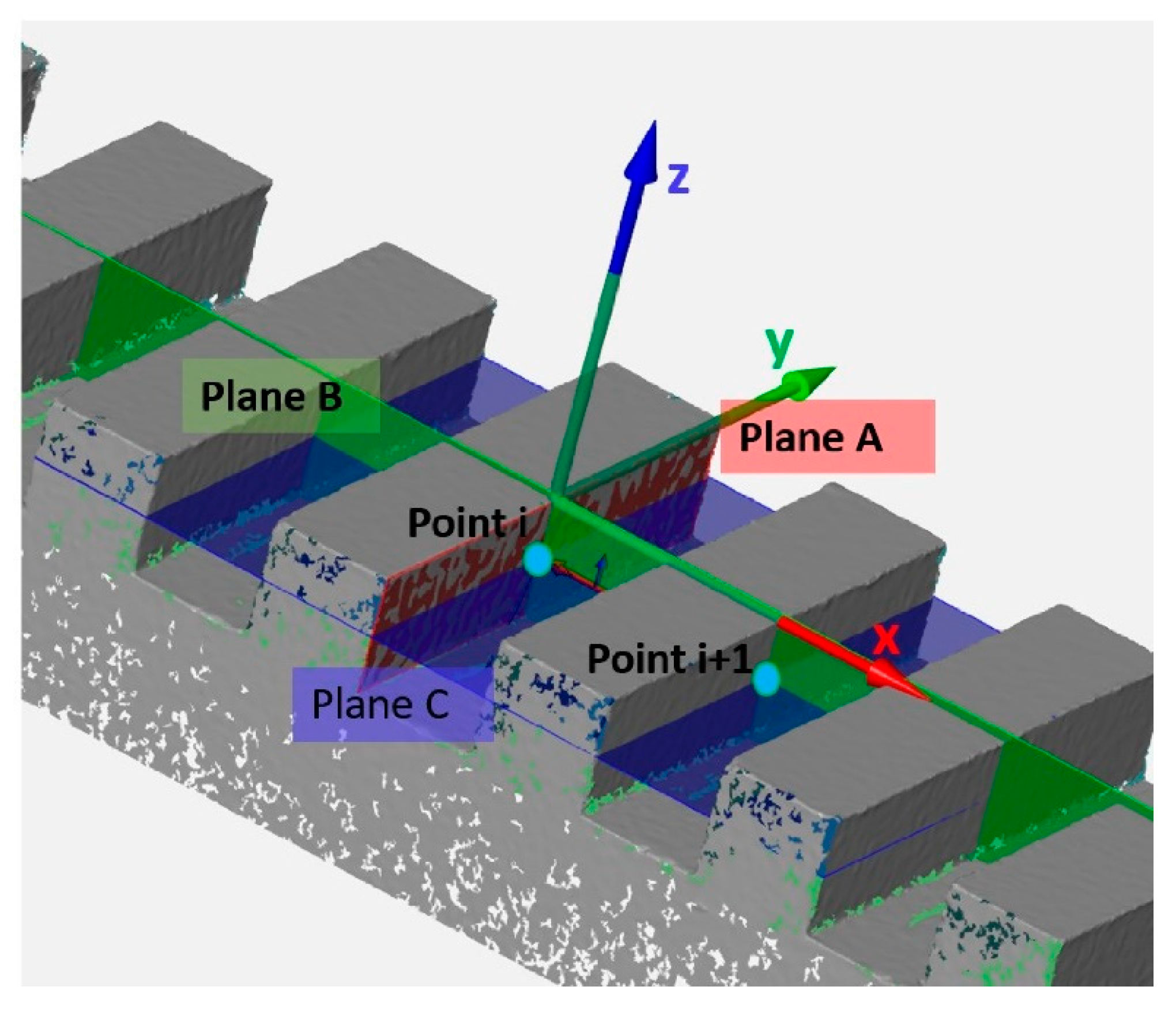



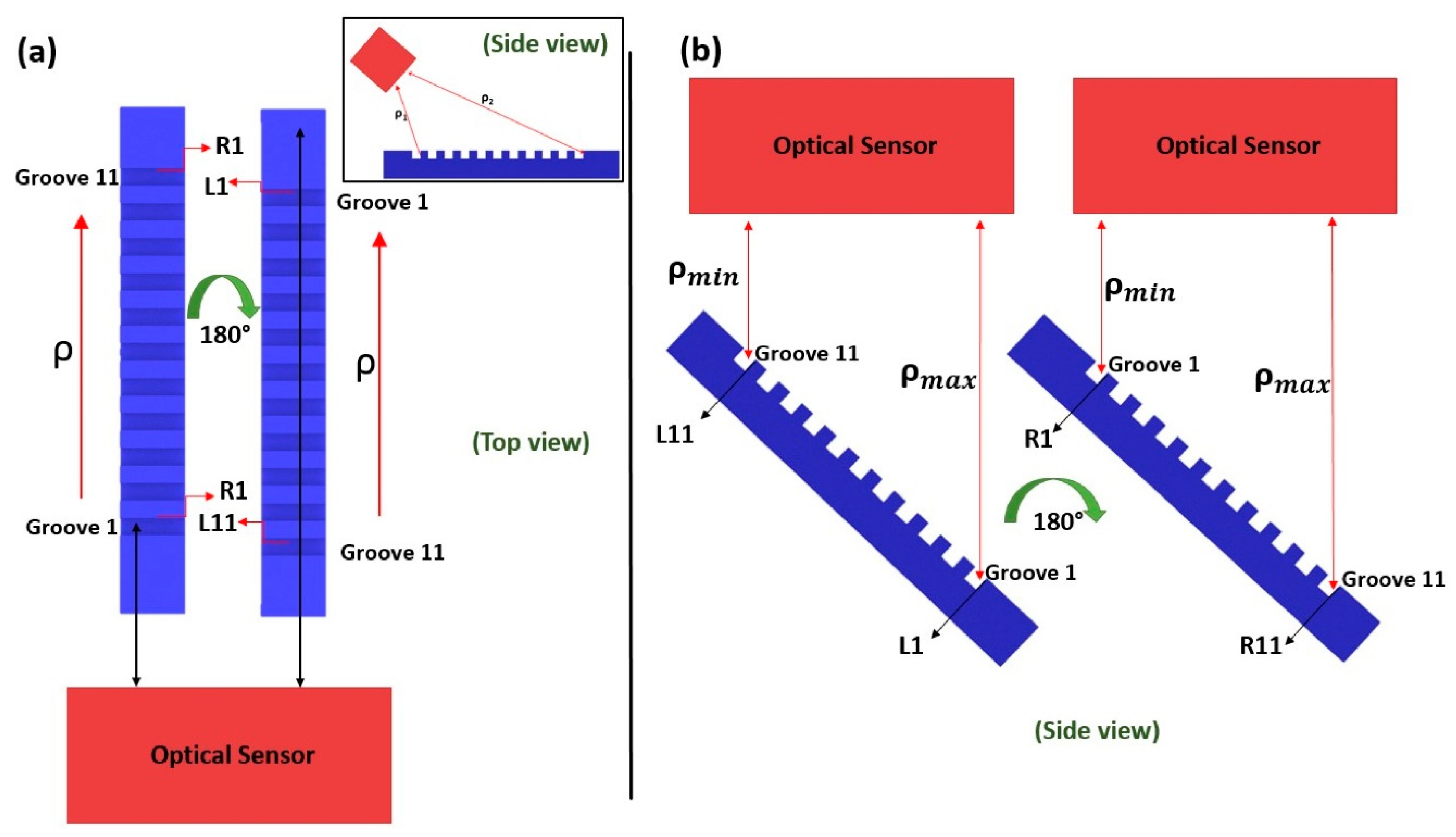

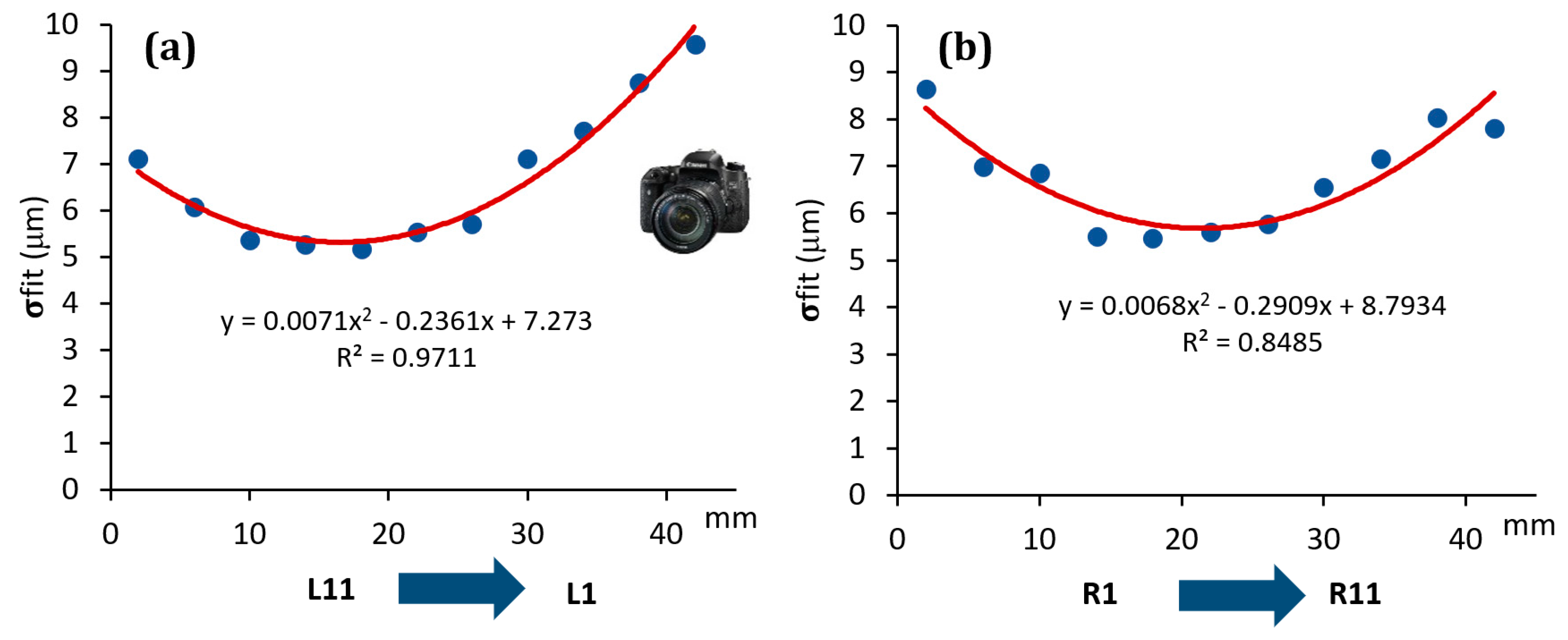
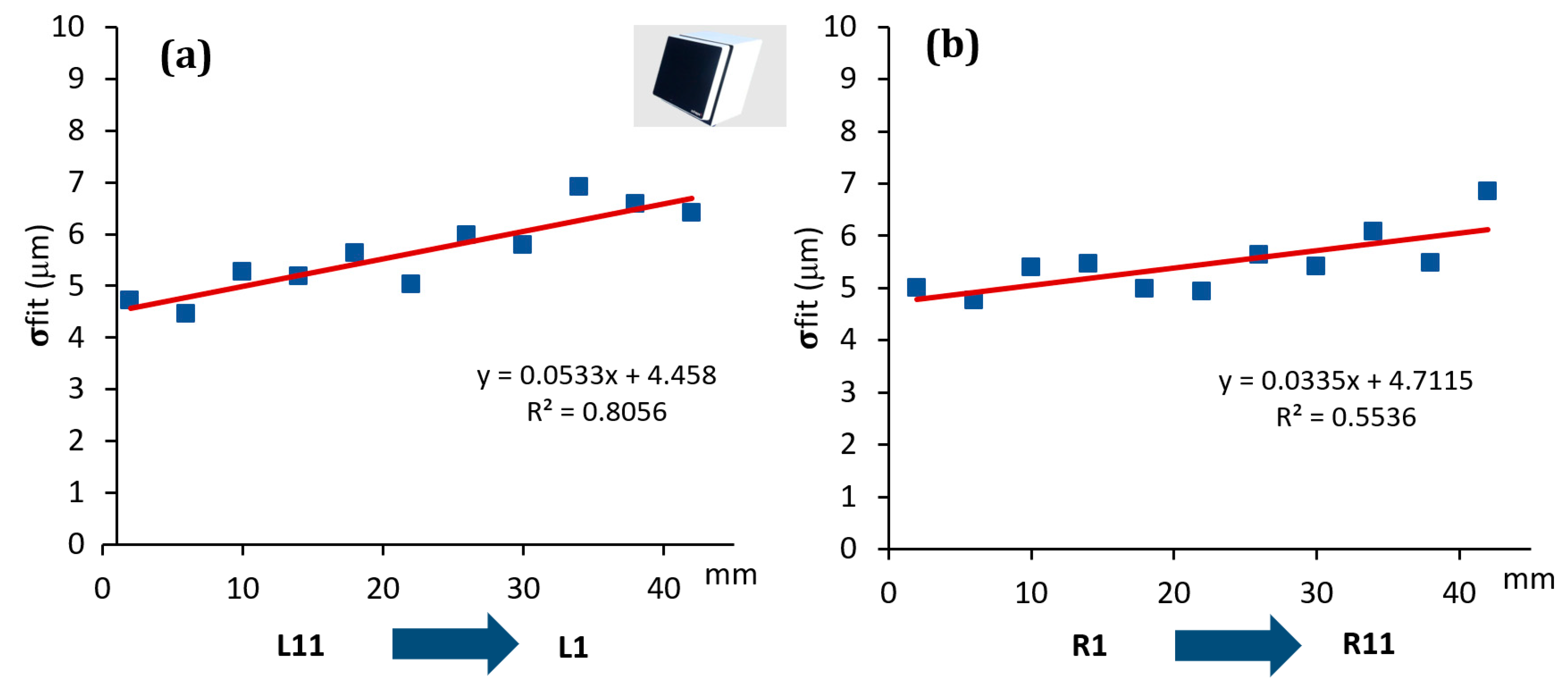

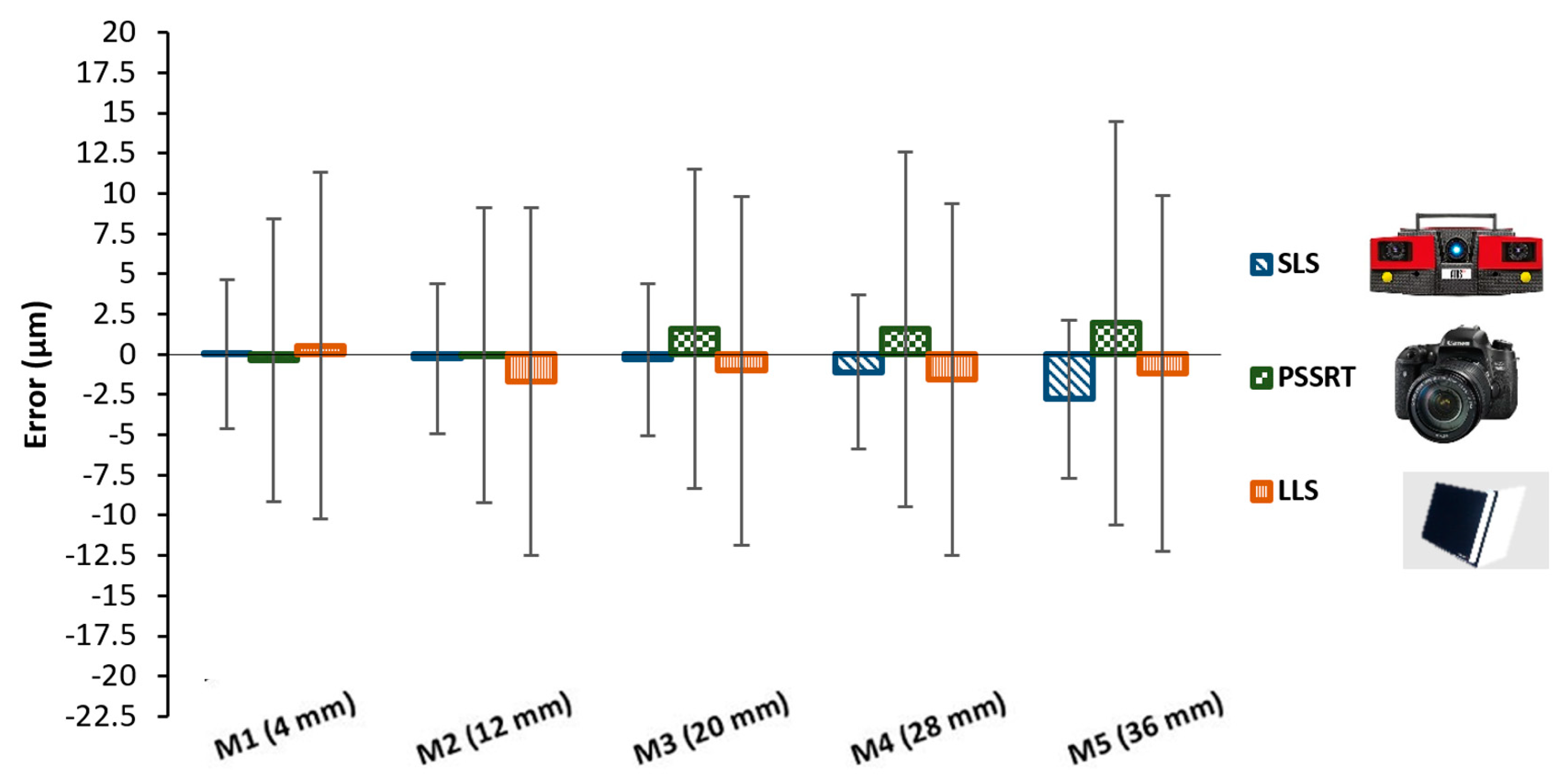
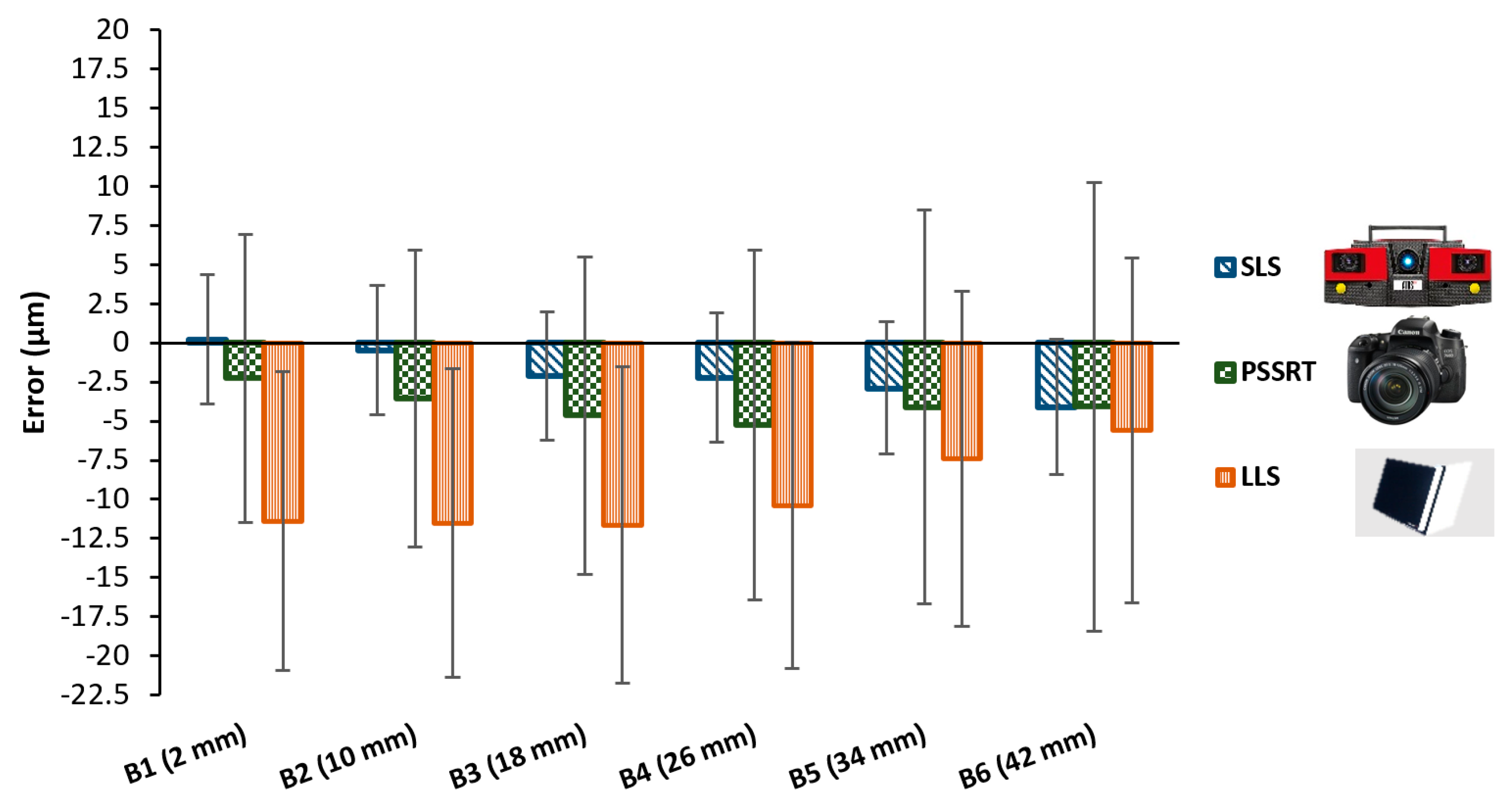
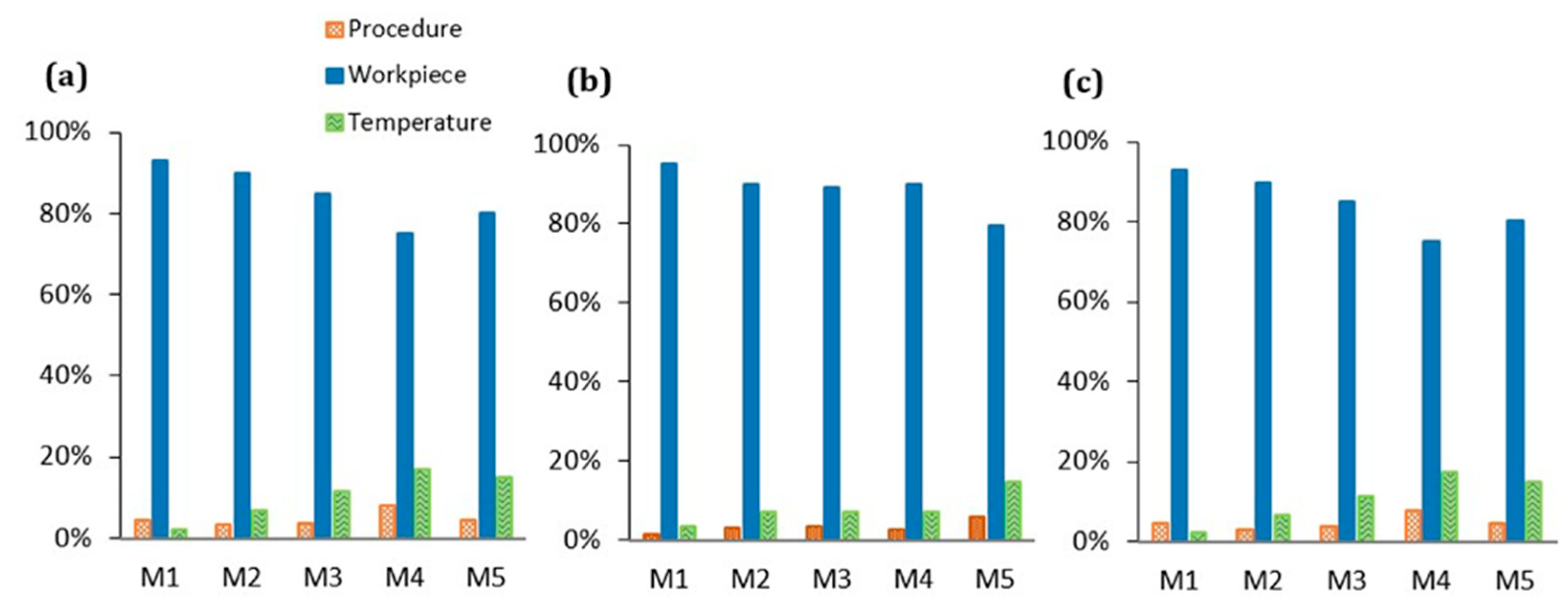
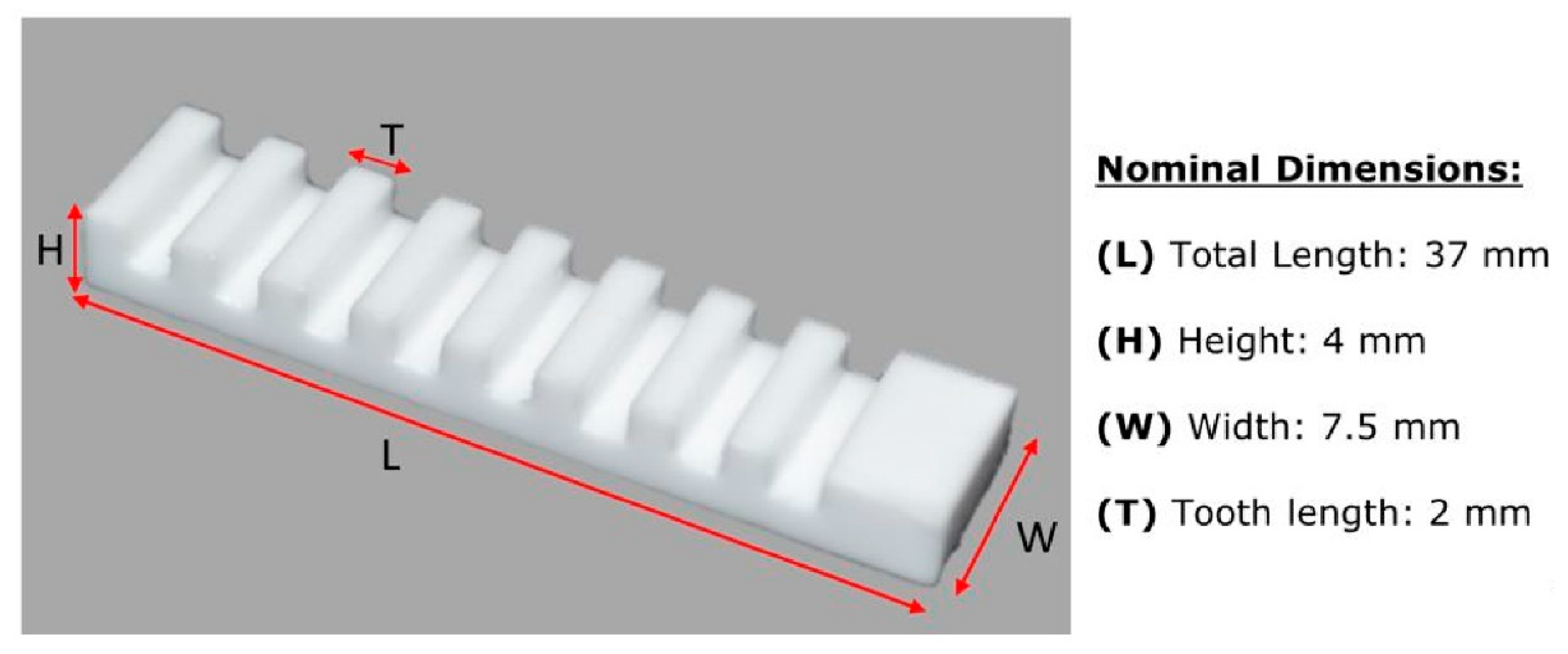
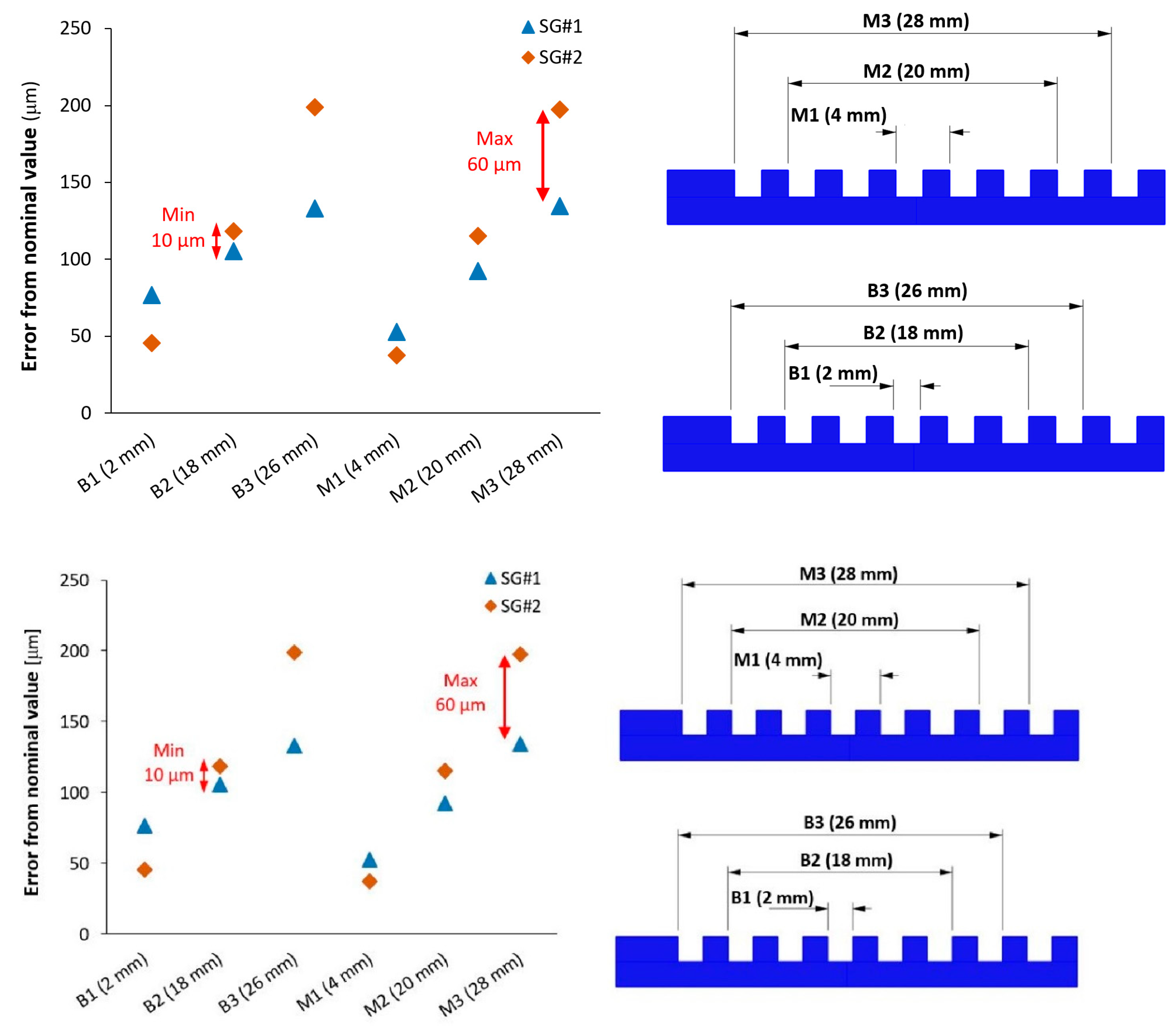
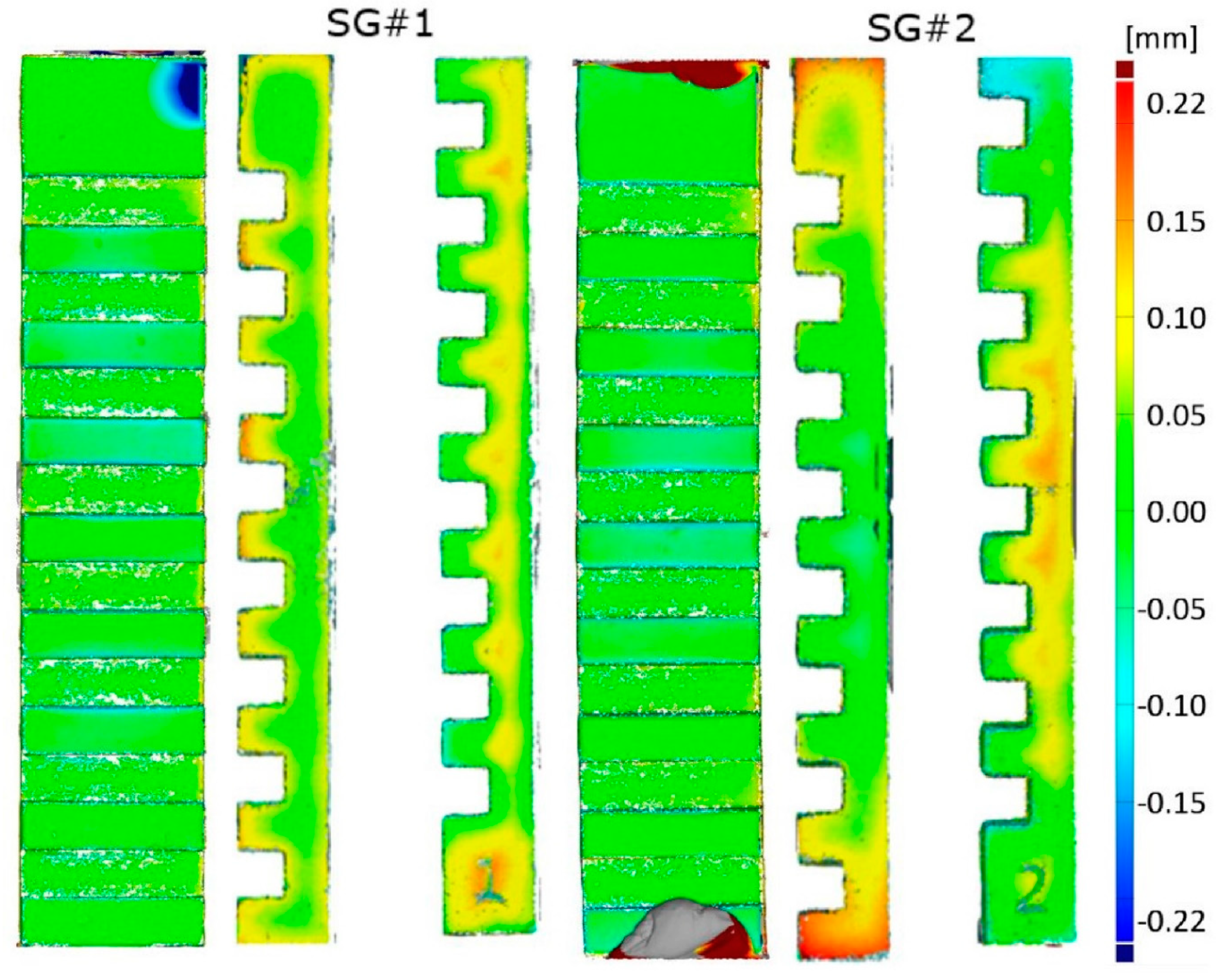
| Uncertainty Component | Symbol | Type | Estimation | Distribution | SLS | LLS | PPSRT |
| Reference | ur | B | Reference Uncertainty | Rect. | Ui/ | Ui/ | Ui/ |
| With i representing each measurand | |||||||
| Optical Interaction Scanner/Workpiece | uw | A | Fitting Error | Rect. | σfitting error | ||
| Environment | ue | B | Temperature variation | U-shaped | ±1° C | ±1.5° C | ±1° C |
| Procedure | up | A | Repeated measurements | Normal | σSLS/ | σLLS | σPSSRT |
| With σ the standard deviation of n repetitions | |||||||
© 2020 by the authors. Licensee MDPI, Basel, Switzerland. This article is an open access article distributed under the terms and conditions of the Creative Commons Attribution (CC BY) license (http://creativecommons.org/licenses/by/4.0/).
Share and Cite
Guerra, M.G.; De Chiffre, L.; Lavecchia, F.; Galantucci, L.M. Use of Miniature Step Gauges to Assess the Performance of 3D Optical Scanners and to Evaluate the Accuracy of a Novel Additive Manufacture Process. Sensors 2020, 20, 738. https://doi.org/10.3390/s20030738
Guerra MG, De Chiffre L, Lavecchia F, Galantucci LM. Use of Miniature Step Gauges to Assess the Performance of 3D Optical Scanners and to Evaluate the Accuracy of a Novel Additive Manufacture Process. Sensors. 2020; 20(3):738. https://doi.org/10.3390/s20030738
Chicago/Turabian StyleGuerra, Maria Grazia, Leonardo De Chiffre, Fulvio Lavecchia, and Luigi Maria Galantucci. 2020. "Use of Miniature Step Gauges to Assess the Performance of 3D Optical Scanners and to Evaluate the Accuracy of a Novel Additive Manufacture Process" Sensors 20, no. 3: 738. https://doi.org/10.3390/s20030738
APA StyleGuerra, M. G., De Chiffre, L., Lavecchia, F., & Galantucci, L. M. (2020). Use of Miniature Step Gauges to Assess the Performance of 3D Optical Scanners and to Evaluate the Accuracy of a Novel Additive Manufacture Process. Sensors, 20(3), 738. https://doi.org/10.3390/s20030738







